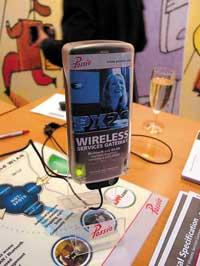Wireless technologies in companies, centres and universities

The Science, Technology and Innovation Plan of the Basque Government 2001-2004 has presented the Wireless project as one of the main strategic research projects. The objective of strategic research is to contribute to responding to the technological needs and challenges of society in the future. To do this, it will try to develop and generate the necessary knowledge and promote new actions in companies.
General and more specific objectives
One of the most important objectives of this project is the strengthening of the wireless area in CEIT, ESI, IKERLAN and ROBOTIKER technology centers. In this way, it would be about generating new technologies and making transfers related to wireless, mainly for use by the producer.
On the other hand, they would like to develop a wireless market offering in the auxiliary subsector of wireless systems, new companies based on specialized services, mobile content providers, etc.

For the creation and development of new products and applications, researchers will take advantage of the current advantages of wireless technology in the market and provide added value to them.
In addition to the general objectives, those responsible for this project have defined objectives related to international cooperation. In fact, the VI European Union. The Framework Program attaches great importance to wireless technologies. The Wireless program will therefore try to take advantage of this interest to create and develop new systems and applications in the Autonomous Community of the Basque Country.
Prior to this project, the AWARE study was presented between several European regions. It analyzed the use of wireless technologies (wireless and mobile technologies) in these regions. For the future, collaboration is sought among all.
What is wireless technology?

The Wireless program includes thirty projects. All are independent, but have the same theme: wireless technologies and mobile technologies.
But what is wireless technology? Within Wireless technology we can find systems such as offline systems, satellite systems, personal networks (peripheral connections), local networks or access networks (television, fixed wireless networks, cellular networks…). With all these systems we must take into account other elements such as antennas, front-end, RF microsystems, etc.
In these systems, optical or electromagnetic communication is done without mechanical support, that is, if the distance is millimeters (conctless systems) or several kilometers (satellites), the communication between them is done without cable or fiber.
The most widely used applications of systems used by wireless technologies are communication, location and identification.
Wireless systems have advantages over others. It can mainly be said that they are very easy to implement (there is nothing more to see the ease of installation of the Internet in rural areas). Moreover, this system does not generate too much cost and has great mobility.


In addition, much is currently being done to improve the safety and toughness of wireless and mobile technologies. In wireless technologies, researchers would like to reach the same level as the cable or fiber optic systems used so far.
Wireless Program Organization
The Wireless program consists of R&D&i (Research, Development and Innovation) actions and complementary actions. These actions are being organized between technology centers and universities. They carry out basic research for the creation and development of different applications. This type of action involves 70% of the researchers of the entire program.
Complementary events include actions to disseminate wireless technologies and training in this type of technology. On the other hand, researchers also intend to take a series of measures to monitor the risks that may arise in this field.
In addition, each of the participating universities and technology centres (University of the Basque Country, Mondragon Unibertsitatea and Tecnun) will have a specific job. All of them will participate in the development and coordination of a project. The objective of this project will be the technological development of a wireless broadband system. That is, they will analyze the evolution of wLAN networks (wireless local networks).

This project is working with wireless short-distance (less than 100 m) and broadband (500 Mbit/s) systems. These studies serve for applications of local connections at home, vehicle, company or factory, such as connection to already installed networks, audiovisual distribution, high-speed buses, MAC levels (network access control) and networks, ensuring the quality of the services offered, pilot applications, etc.
The Etortek Wireless program, managed by the Robotiker Technology Center, is scheduled for 2004.
- Train a hundred people capable of working with this technology in the business world.
- 16 doctoral theses.
- Publication of 25 articles in well-known journals and scientific publications.
- 9 presentations related to the subject in different congresses.
- 7 patents.
- 7 new companies based on this technology.
- 30 direct jobs.
- 100 indirect jobs.





